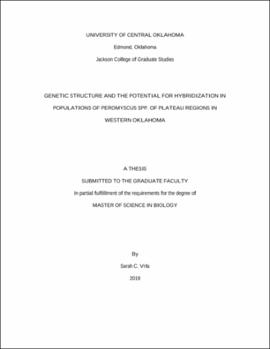| dc.contributor.advisor | Haynie, Michelle L., 1975- | |
| dc.contributor.author | Vrla, Sarah C. | |
| dc.date.accessioned | 2020-07-09T14:41:36Z | |
| dc.date.available | 2020-07-09T14:41:36Z | |
| dc.date.issued | 2019 | |
| dc.identifier.other | (AlmaMMSId)9982673580102196 | |
| dc.identifier.uri | https://hdl.handle.net/11244/325125 | |
| dc.description.abstract | There are many evolutionary mechanisms that influence the process of speciation, or the creation of new species. One such process is genetic recombination. Hybridization can be argued to be a unique form of genetic recombination, and therefore studies offering insight into the mechanisms influencing hybridization can enhance our understanding of speciation as a whole. Hybridization also can cause shifts in ecological balances of an ecosystem in the form of increasing competition or influencing changes in disease ecology if offspring produced are viable. The genus Peromyscus is invaluable in the study of hybridization as a result of an extensive data set already existing for the evolution, taxonomy, and genetic divergence of the subgenera, species groups, and species included within it. Two such species, Peromyscus maniculatus and P. leucopus are located within the same subgenus (Peromyscus) and separate species groups (maniculatus group and leucopus group, respectively) that diverged approximately 2.5 million years ago. These two species have extensive ranges across North America and overlap across much of the eastern half of the United States, including Oklahoma. During a small mammal survey of Four Canyon Preserve (FCP) in western Oklahoma (Ellis County), a unique group of Peromyscus individuals were collected that exhibited a distinct sharing of characteristics typically used to distinguish these species and could not be identified as P. maniculatus or P. leucopus. In this study I investigated hybridization as a potential explanation for this merging of morphological characteristics through the use of 11 nuclear microsatellite loci, restriction fragment length polymorphism (RFLP) analysis of the mitochondrial (mtDNA) cytochrome b (Cyt b) gene, and skull morphometrics analysis. A total of 158 samples collected from FCP, across the state of Oklahoma, and further across the range of the two species were examined. An individual was considered to be a putative hybrid (i.e., admixture individual) in three ways: a disagreement between the two species ID methods, RFLP analysis of Cyt b and a microsatellite locus (PML08); a disagreement between either species ID method with the complete microsatellite dataset (STRUCTURE) assignment; or being identified as an admixture individual in the STRUCTURE analysis. Skull morphometrics data were inconclusive at this time and further data collection is needed before results can be interpreted from data reported here. Through these methods, 65 out of 158 specimens examined were identified as admixture individuals, which offers support that these two species might be hybridizing within sympatric areas. Additionally, results offer evidence for new locality records and/or range expansions within the species, suggesting the need for further research into the current distribution of both species across North America. | |
| dc.rights | All rights reserved by the author, who has granted UCO Chambers Library the non-exclusive right to share this material in its online repositories. Contact UCO Chambers Library's Digital Initiatives Working Group at diwg@uco.edu for the permission policy on the use, reproduction or distribution of this material. | |
| dc.title | Genetic structure and the potential for hybridization in populations of Peromyscus spp. of plateau regions in western Oklahoma. | |
| dc.type | Academic theses | |
| dc.contributor.committeeMember | Fenwick, Allyson | |
| dc.contributor.committeeMember | Wilson, Gregory | |
| dc.thesis.degree | M.S., Biology | |
| dc.subject.keywords | Cytochrome b | |
| dc.subject.keywords | Hybridization | |
| dc.subject.keywords | Microsatellites | |
| dc.subject.keywords | Peromyscus | |
| dc.identifier.oclc | (OCoLC)1120823874 | |
| uco.group | UCO - Graduate Works and Theses::UCO - Theses | |
| thesis.degree.grantor | Jackson College of Graduate Studies. | |
